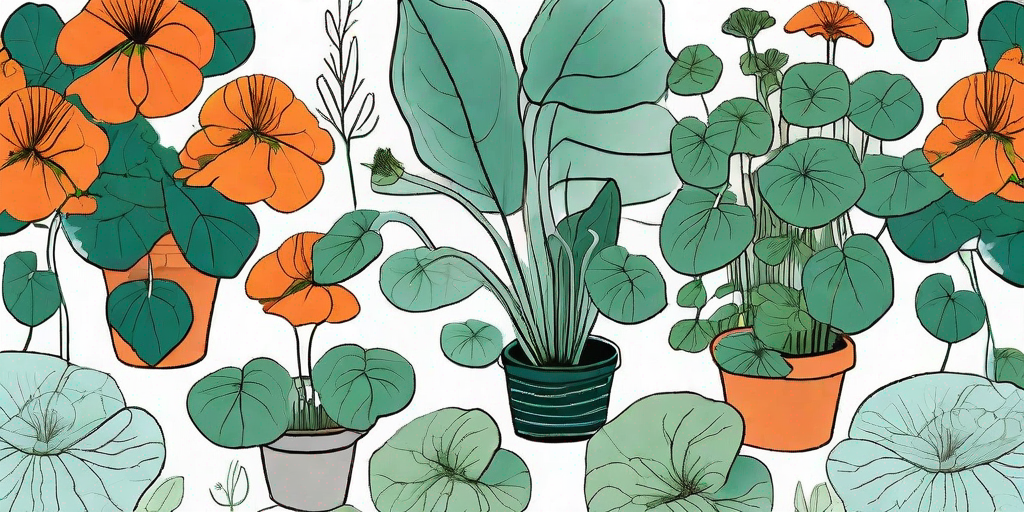
Gardening enthusiasts, green thumbs, and plant parents, gather 'round! Today, we're diving deep into the world of Nasturtiums and their perfect plant partners. If you're looking to add a splash of vibrant color and a dash of cheeky charm to your garden, you've come to the right place. So, grab your trowel, put on your gardening gloves, and let's get digging!
The Nitty-Gritty on Nasturtiums
Before we delve into the ideal companions for Nasturtiums, let's get to know this vivacious vine a little better. Nasturtiums, with their bright, round leaves and flamboyant flowers, are a sight for sore eyes. They're not just pretty faces, though. These hardy plants are as tough as they come, making them a favorite among gardeners worldwide.
Native to South and Central America, Nasturtiums are known for their adaptability and resilience. They thrive in full sun but can tolerate partial shade. They're also not picky about soil, although they do prefer well-drained conditions. But the real kicker? Nasturtiums are edible! Their peppery leaves and flowers can add a zesty kick to salads and other dishes. Talk about a plant that pulls its weight!
Types of Nasturtiums
There are two main types of Nasturtiums: trailing and bush. Trailing Nasturtiums, as the name suggests, are climbers. They can reach up to 10 feet in length and are perfect for covering fences, walls, or trellises. Bush Nasturtiums, on the other hand, are compact and ideal for containers or small gardens.
Both types come in a variety of colors, from fiery reds and oranges to sunny yellows and creamy whites. Some varieties even have variegated leaves for an extra touch of drama. With such a wide range of options, there's a Nasturtium for every garden and gardener.
Nasturtium's Perfect Plant Partners
Now that we're well-acquainted with Nasturtiums, let's meet their perfect plant partners. These are plants that thrive in similar conditions and complement Nasturtiums in terms of growth habits, aesthetics, and benefits.
Choosing the right plant partners can enhance your garden's beauty and productivity. It can also help keep pests at bay and improve soil health. So, without further ado, let's dive into the world of plant companionship!
Marigolds
Marigolds and Nasturtiums are a match made in gardening heaven. Both love the sun and aren't fussy about soil. Plus, Marigolds' vibrant yellow and orange blooms perfectly complement Nasturtiums' colorful flowers. But the benefits don't stop at aesthetics. Marigolds are known for their pest-repelling properties, making them a great partner for Nasturtiums.
Plant Marigolds around your Nasturtiums to create a stunning color contrast and keep pesky bugs at bay. Just remember to give both plants plenty of space to grow and flourish.
Tomatoes
Tomatoes and Nasturtiums are another dynamic duo. Nasturtiums can help deter pests like aphids and whiteflies, which are notorious for attacking tomatoes. Plus, the bright flowers of Nasturtiums can attract beneficial insects like bees, which can help pollinate your tomato plants.
Plant Nasturtiums around your tomato plants for a protective and productive partnership. Just make sure to provide a trellis or support for your tomato plants to climb on.
FAQs
Can Nasturtiums grow in pots?
Absolutely! Nasturtiums are versatile plants that can thrive in pots. Just make sure to choose a pot with good drainage and plenty of room for growth. Bush Nasturtiums are particularly well-suited for container gardening.
Do Nasturtiums need a lot of water?
Nasturtiums are pretty low-maintenance when it comes to watering. They prefer well-drained soil and can tolerate dry conditions. However, they do appreciate a good drink during prolonged dry spells. Just be careful not to overwater, as this can lead to root rot.
Are Nasturtiums perennial or annual?
Nasturtiums are typically grown as annuals, but they can be perennial in frost-free climates. They also self-seed readily, so you can enjoy their vibrant blooms year after year.
Conclusion
There you have it, folks! A comprehensive guide to sprucing up your garden with Nasturtiums and their perfect plant partners. Whether you're a seasoned gardener or a budding green thumb, we hope this article has inspired you to give these vibrant vines a go. Happy gardening!















